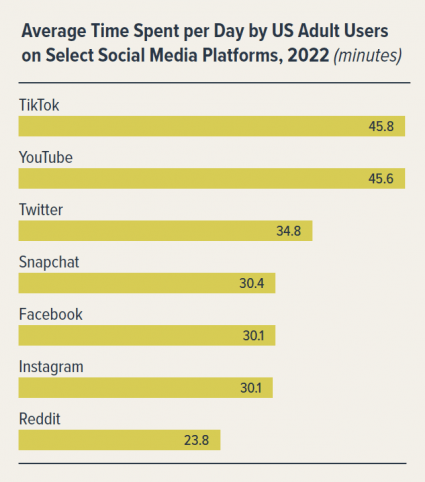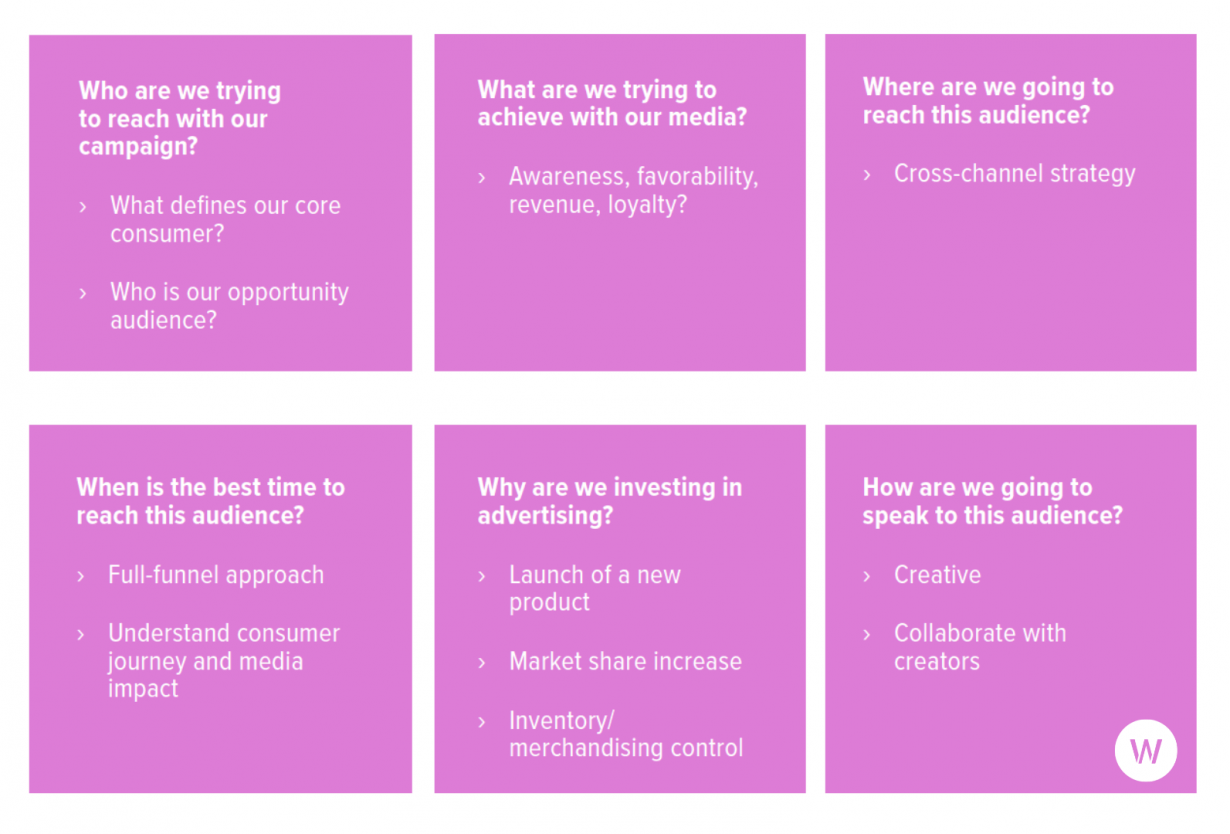Social media has come a long way since the days of a/s/l, AIM, and MySpace. The world is more connected than ever and consumers are posting, engaging, learning, and exploring every minute of every day.
They’re not just following friends, family, or their favorite influencers, they’re also using social media channels of all kinds to discover brands, research services, and purchase products. If your brand isn’t part of those conversations, you’re leaving the door open to the competition.
Your social media mix and strategy need to reflect that reality and meet your customers where they are. It’s time to embrace more emerging channels even if they don’t have every targeting feature or the full attribution capabilities of major digital players like Google and Facebook.
After all, if consumers aren’t spending all of their time on one platform, why would your brand?
What upcoming social channels are part of the new purchase journey for consumers?
Consumer preferences are changing: according to eMarketer, adult users are using different channels, spending more time on TikTok and YouTube than on Facebook and Instagram. Social platforms outside the Meta ecosystem are emerging as major contenders for your budget.

Source: eMarketer
The most important emerging social platforms from a consumer point of view are:
- TikTok
- YouTube
- Snapchat
If consumers are using these platforms, they need to at least be part of your media mix consideration set. Start by understanding how people are using each channel and what each platform’s respective strengths and challenges are.
Evaluating New Social Media Channels: TikTok
According to eMarketer, US TikTok users will spend more time with the social media platform this year than YouTube users will spend on YouTube. It already shot past Facebook and Instagram. TikTok is increasingly valuable as a discovery platform for users, either in place of a search engine or in lieu of other social networks.
Strengths:
- High Level of Attention: The sound-on, full-screen nature of the platform encourages users to lean in when consuming content instead of passively scrolling.
- Early-to-Market Advantage: TikTok as an advertising platform is still quite young, and the platform has not yet been fully optimized yet for ads. That means a more positive user experience where paid ads are seamless with organic content.
- Increased Signals: As the ability for platforms to track users outside of their apps becomes increasingly difficult due to privacy restrictions, they face signal deprecation, which affects their ability to serve relevant and timely ads. Because TikTokers are spending so much time engaged in the platform, TikTok is able to understand a lot about its users via first-party data that can be used to determine ad relevance.
Challenges:
- Upper-Funnel First: To be effective, you need to nurture the TikTok pixel by approaching media with a stair-step approach that focuses first on driving upper-funnel conversions to give the pixel and TikTok algorithm enough time to learn how to optimize delivery.
- Unique Creative: TikTok creative is very different from other social networks, and that usually means content needs to be made specifically for the platform instead of leveraging the same creative from other social platforms.
Evaluating New Social Media Channels: YouTube
Google has invested a lot in building out YouTube’s advertising capabilities; it’s built to be a one-stop-shop for full-funnel marketing, so you can create demand, capture that interest, and convert consumers into customers.
It integrates with Google search campaigns and amplifies direct response efforts on other channels, and can serve as a testing ground for video creative.
Strengths:
- Halo Effect: YouTube marketing has a significant lift beyond its measurable direct impact. Even if consumers don’t take direct action immediately after engaging with a YouTube video ad, there is still a halo effect associated with that interaction that often correlates with a boost in performance for lower-funnel campaigns.
- Creator Platform: YouTube is the original home for internet creators, and they’re introducing more monetization opportunities for creators to keep them from defecting to the competition as influencer marketing and creator partnerships become increasingly powerful strategies on social.
- TV Connection: More and more people are watching YouTube on TVs instead of smartphones, so you can test different messaging and creative on YouTube to identify what will likely work on TV, then iterate and expand on what works for your most important audiences on YouTube that align with TV audiences.
Challenges:
- Social Commerce Capabilities: Most social platforms doubled down on efforts to enhance their commerce offerings over the last few years, but YouTube lagged behind. Now it’s playing catch up.
- Copy Cat: YouTube is moving fast to shore up its business against new competitors like TikTok by launching more social commerce options, short video formats in YouTube Shorts, and more vigorous creator offerings, but, like Meta’s platforms, it remains to be seen how it will fully differentiate its value proposition.
Evaluating New Social Media Channels: Snapchat
Snapchat offers a unique value proposition: with 347 million daily users that span 75% of millennial and Gen Z consumers, Snapchat’s emphasis on direct, personal connections has created a unique community free of much of the toxicity associated with social, which provides an opportunity for brands to meaningfully reach, engage, and convert new consumers.
Strengths:
- Cost: Even against similar campaign objectives, Snap CPMs are lower than other platforms with just as strong KPI performance for ROAS and CPA.
- Privacy: The negative impact of iOS on Snap has been less significant compared to other social platforms because Snap already had stronger privacy and brand safety restrictions in place.
- Leader in AR: Snap has the most mature and accessible AR offerings for brands and users from both an engagement and advertising perspective.
- Strong Video Placement: It has a robust set of options for short-form video content and premium video placement.
Challenges:
- Third-Party Measurement: Measurement in third-party reporting solutions like Google Analytics can be a struggle.
- Personal: Users tend to be more focused on personal communication through the camera and more oriented toward fun than some of the other big platforms, which can be a challenge for brands used to more direct sales messaging.
Evaluating New Social Media Channels: Twitter
Twitter is basically the water cooler of today’s increasingly virtual world; Twitter users are looking for news and reacting to new information. The platform has been beefing up its performance offering to appeal more to brands and give them new ways to connect with its 217 million monetizable daily active users.
Strengths:
- Word of Mouth: With word of mouth more impactful than ever, people crave reviews and recommendations, all of which are currently happening on Twitter.
- Discovery: Users also like discovering what’s new on Twitter: people spend 2x more time viewing launch ads on Twitter and are 3.3x more likely to take action post-launch ad exposure.
Challenges:
- Performance Offering: They are not as advanced in their performance capabilities as some other platforms, but the platform has made a big investment in those products in the last year.
- Brand Safety: Because of the often combative nature of the platform, brands can be understandably nervous about getting involved in the wrong conversations on Twitter.
Evaluating New Social Media Channels: Reddit
Reddit communities are not built around people, but topics, which encourages a different kind of sharing than on traditional social channels. People go to Reddit to learn, get recommendations, and talk frankly about many topics that may align with your business.
Strengths:
- Niche Audiences: An unduplicated and highly engaged audience across nearly every interest that can drive incremental conversions. Redditors are actively seeking, not aimlessly scrolling.
- KarmaLab Team: While you don’t need to create Reddit- only assets, you should understand what matters to the communities that matter to you. Reddit’s KarmaLab team can help you understand the tone, copy, and assets that will resonate best with your audience.
- Market Research: Whether or not you run paid ads on Reddit, the conversations happening there make it a great source for consumer trends and market research.
Challenges
- Evolving Ad Tech: Reddit does not have the same granular targeting capabilities or automated campaign management as some of its competitors.
- “Anti-Advertising” Sensibility: Redditors are savvy to marketing tricks—there’s even a subreddit of ~200K subscribers called /r/hailcorporate where Redditors try to identify and document brand placements across the site. Users have the power to respond in real-time, as well as upvote/ downvote power to dictate what they like and what they don’t like, and brands have to accept the results.
Evaluate these channels based on your audience and business goals, not just the platform’s ad offerings.
There’s not one “right way” to diversify your social strategy: you need to evaluate your channel mix based on your business goals and your audience, as well as the capabilities, cost, and level of effort you’re willing or able to put into each platform.
Make sure you have defined business objectives or else you can get stuck in an endless evaluation loop that results in wasted time and effort as you try to decide which channels are right for you. That includes asking questions about your audiences, general goals, and creative strategy.

Ask the right question when building your business objectives to help you identify the right platforms.
Social media is now the real center of the overall digital experience for most people. Your brand needs to be ready to engage those audiences effectively with a diversified, integrated approach to social strategy that incorporates multiple channels and touchpoints.
You need to make sure you’ve spread your investment out to win on social in today’s world. Assess your current social media mix to see if its sufficiently diversified by asking:
- Does my brand have over 75% of its social media budget invested in a single platform?
- Is our audience on social channels my brand isn’t investing in?
- Are we adequately filling the upper funnel or is my brand over-indexed on direct response?
- Does my brand have a testing strategy in place to try out new channels and campaign types?
- Are we making decisions about social spend based only on granular performance KPIs and efficiency metrics?
- Are we making decisions about channel mix based mostly on targeting and attribution capabilities vs. potential to drive discovery or purchase?
- Are we seeing diminishing returns on our social investment?







Responses